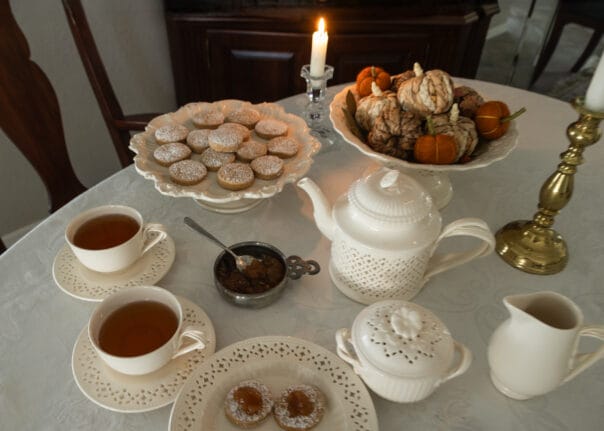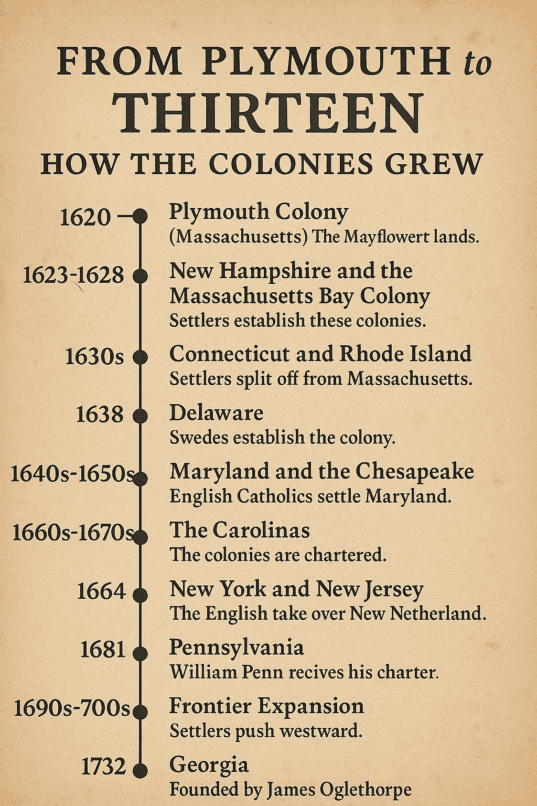Colonial Cooking: Bylandersea America 250
Before “no taxation without representation” became a rallying cry, tea and coffee were already simmering at the heart of colonial life. In 18th-century America, what people drank wasn’t just about taste — it reflected class, culture, and eventually, politics.

The Social Cup
In the early 1700s, tea was the drink of refinemen, imported from China and served in delicate porcelain cups. It arrived through the ports of Boston, New York, Philadelphia, and Charleston, carried in crates stamped with the mark of the British East India Company. Wealthier colonists displayed tea tables, silver strainers, and ornate teapots as symbols of gentility.
Coffee, meanwhile, arrived from the Caribbean and South America. It was often roasted at home, its earthy aroma filling kitchens from Virginia to New England. While tea was tied to polite society, coffee was practical — easier to store and less fragile. Both drinks required imported sugar, often produced by enslaved labor on West Indian plantations — an early reminder of how global trade intertwined with colonial life.
Taverns and Tea Tables
Public houses and taverns served as the social networks of the day. Men gathered over tankards of ale or steaming coffee to debate politics, trade news, and plan ventures. Taverns in cities like Boston and Philadelphia became hotbeds of revolutionary discussion. Coffeehouses, modeled after London’s lively establishments, sprang up where printers, merchants, and thinkers exchanged ideas that would soon fuel independence.

At home, the tea table became the center of domestic sociability. Women invited friends to share “a dish of tea,” gossip, and news. Tea sets were prized possessions, often imported from England or Holland. These quiet domestic scenes, however, would take on a new meaning once Parliament began taxing the colonies.
Taxation and Tempers Boil
The British Tea Act of 1773 gave the struggling East India Company a monopoly on tea sales in America, in essence bypassing colonial merchants and asserting imperial control. The result was fury. Tea, once a symbol of refinement, became the symbol of resistance.
In Boston, colonists disguised as Mohawk Indians boarded ships in the harbor and dumped 342 chests of tea into the icy waters. The Boston Tea Party wasn’t just about tea — it was a rejection of royal authority and taxation without representation. Across the colonies, households began to boycott tea, turning instead to coffee, herbal infusions, and “liberty tea” brewed from native plants like raspberry leaves, mint, and sassafras.
Even in genteel homes, pouring tea became an act of political conscience. Patriots proudly served coffee or local herbs; Loyalists quietly continued their British brews. The beverage in your cup could mark where your loyalties lay.
From Tea to Freedom
By the eve of the Revolution, coffee had replaced tea as the preferred drink in many American homes — a small but telling shift. The act of sipping became symbolic: coffee for liberty, tea for tyranny. Merchants and soldiers alike relied on it during the long war years, roasting and brewing whenever possible.

After independence, America’s love affair with coffee deepened, while tea slowly regained acceptance as a neutral pleasure. But those early years proved that even something as simple as a warm drink could stir the heart of a revolution.
☕ Did You Know?
“Liberty Tea” was often made from mixtures of local herbs — raspberry leaves, goldenrod, or mint — dried and steeped to resemble imported tea. Colonists also used the bark of sassafras or roots of dandelion for coffee substitutes during the boycotts.

🕯️ Where to Experience It Today
- Boston Tea Party Ships & Museum, Massachusetts: See replicas of the ships and toss “tea” into the harbor yourself.
- Colonial Williamsburg, Virginia: Enjoy a traditional tea service at the Governor’s Palace or sample coffee in a colonial tavern.
- Philadelphia’s City Tavern (recreation): Once a favorite of the Founding Fathers, this spot celebrates 18th-century menus and beverages.
- Kenmore: Fredericksburg, Virginia: I purchased a bag of Liberty Tea in the Kenmore gift shop. It’s made from rose petals, rose hips, mint, lemon verbena, strawberry leaves and raspberry leaves, and is delicious. (Kenmore was the home of George Washington’s married sister: Betty Lewis.
When sugar was taxed, other sweeteners were substituted, such as molasses, honey, and maple syrup. Below is a recipe for tea cakes or colonial cookies made without white sugar. They have a delicate, light flavor and get just a touch of sweetness from the molasses and honey. I added a sprinkle of confectioner’s sugar on top. Topping them with a dab of jam or apple butter is another way to add a little punch.
Colonial-Style Molasses & Honey Tea Cakes
Yield: about 18–24 cookies (depending on cutter size)
Prep time: ~20 minutes + chilling
Bake time: ~10–12 minutes at 350 °F (≈ 175 °C)
Ingredients
- 2 cups (≈ 250 g) all-purpose flour
- 2 teaspoons baking powder
- ¼ teaspoon salt
- ½ cup (1 stick / ≈ 113 g) unsalted butter, softened to room temperature
- 2 tablespoons molasses (dark or blackstrap for a richer flavour)
- 2 tablespoons honey (preferably a mild-flavoured one)
- 1 large egg, room temperature
- 2 tablespoons buttermilk (or whole milk + ½ teaspoon vinegar, let it sit 5 minutes)
- 1 teaspoon vanilla extract
- Optional: ½ teaspoon ground cinnamon or nutmeg (for a subtle colonial-spiced note)
Instructions
- Pre-heat your oven to 350 °F (≈ 175 °C). Line a baking sheet with parchment paper.
- In a medium bowl, whisk together the flour, baking powder and salt. Set aside.
- In a larger mixing bowl (or stand-mixer with paddle), cream the softened butter until smooth.
- Add the molasses and honey, mixing until blended. Then add the egg, then the buttermilk and vanilla, mixing until just incorporated.
- On low speed (or by hand with a spatula), gradually add the dry flour mixture until a soft dough forms. If you like the optional spice, stir it in now.
- Wrap the dough in plastic or cover and chill in the refrigerator for at least 30 minutes (this helps the dough firm up and roll nicely).
- On a lightly floured surface, roll out the dough to about ¼″ (≈ 6 mm) thickness. Use a biscuit cutter or glass to cut rounds. Re-roll scraps as needed.
- Place the rounds about 1″ apart on the prepared baking sheet.
- Bake for ~10–12 minutes, or until the edges are just beginning to show a light golden hue. (Don’t over-bake — you want a soft interior with a lightly crisp edge.)
- Let the tea cakes rest on the sheet for a couple of minutes, then transfer to a wire rack to cool completely.
Serving & Storage
- Serve these with tea or coffee for a nice “colonial afternoon” feel.
- Store in an airtight container at room temperature for up to 3 days.
- You can freeze the dough (in a log or discs) for up to 1 month; thaw in fridge and then bake as directed. The baked tea cakes also freeze nicely.

For more on the Boston Tea Party, please read: Boston Sparks a Revolution.





